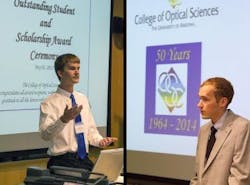Two University of Arizona optical-sciences students chosen for 2014 Astronaut Scholarship
| Benjamin Cromey at the 2013 College of Optical Sciences award ceremony (left); Travis Sawyer at the 2014 award ceremony (right). (Images courtesy of Kristin Waller) |
Two University of Arizona (UA; Tucson, AZ) undergraduates have been named winners of the 2014 Astronaut Scholarship, which was founded by six members of NASA's original Mercury 7 mission.
Senior Benjamin Cromey and junior Travis Sawyer will each receive $10,000 toward their next year of study, to be officially presented in the fall by a member of the Astronaut Scholarship Foundation (ASF). Both are in the optical sciences and engineering program, which is jointly administered by the College of Optical Sciences and the College of Engineering.
The ASF funds an average of 28 awards each year to students at 27 participating universities. It has provided $3.7 million to students in the science, technology, engineering, and math (STEM) fields since 1986. Today, more than 100 astronauts contribute to the program.
Candidates for the scholarship are nominated by faculty members, with each participating university selecting two nominees showing initiative, creativity and excellence in their chosen field. This is the first year that two UA students have been recognized.
Cromey was nominated by professor of optical sciences Robert A. Norwood and assistant research professor of optical sciences Pierre-Alexandre Blanche, for whom he has worked for two years on software integration and characterization of photorefractive polymers. When in high school, Cromey attended a one-week optics camp at the College of Optical Sciences at which time he toured Blanche's 3D display lab, where he now performs his own research.
Cromey is spending the summer in Bothell, Washington, working for Lockheed Martin on high-power lasers for defense applications.
Unusual path to optics
Travis Sawyer was nominated by assistant professor of materials science and engineering Robert Erdmann, who also holds an appointment in the applied mathematics program. Sawyer joined the Erdmann research group, where he works on image processing and software development.
During Sawyer's freshman year at UA, he was mistakenly diagnosed with leukemia and underwent a battery of tests and scans as physicians sought more information about his condition. "During this time, I was exposed to a multitude of optical instruments and devices," says Travis. "I quickly became fascinated with the technology and the unique information it provides on what is otherwise invisible or inaccessible."
This summer, Sawyer is in Stuttgart, Germany performing research in illumination and radiometry at the Institute of Applied Optics. He also works as a software consultant for a Dutch research group, providing data visualization, analysis, and digital infrastructure.
Both students plan to pursue doctorates, then spend time in industry before returning to academia.
